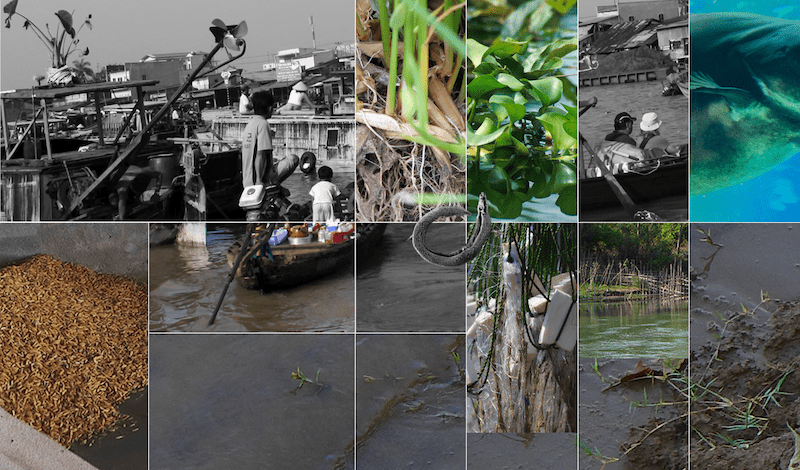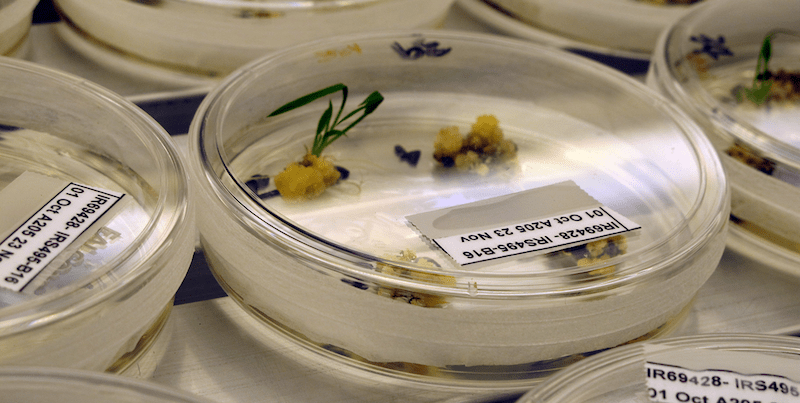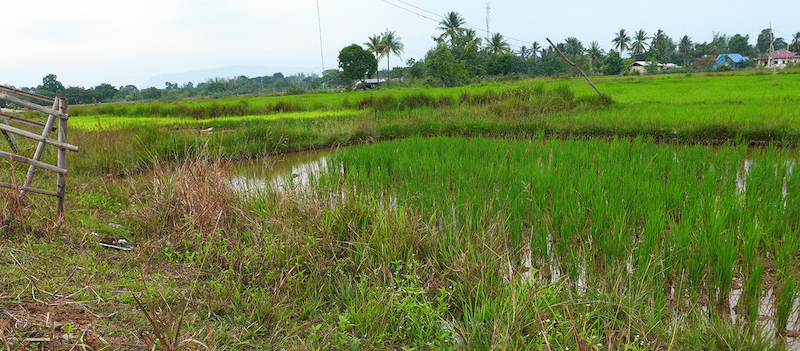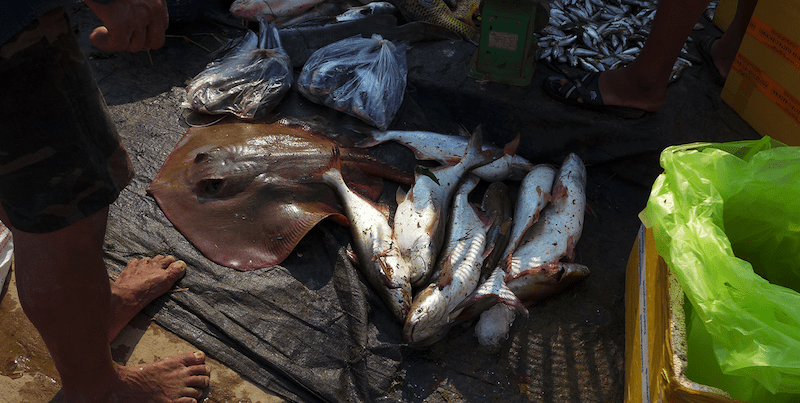
To See a World in a Grain of Rice:
Temporalities of a Flowering Grass and the Great Acceleration
Artist and environmental humanities scholar Elaine Gan tells the story of two different grains of rice. To engineer the ecology and growth cycles of these grains is to change river flows and the multiple rhythms of life and death. An unintended assemblage of seeds, fertilizers, invasive species, and megadams are giving rise to novel—and dangerous—connections. Gan proposes that coordination and timing matter just as much as the materiality and productivity of crops. The temporalities of multispecies worlds merit urgent attention.
Rice, a flowering grass, has become one of the most essential food crops today. Countless varieties of this highly adaptable, semiaquatic plant have evolved through contingent encounters and situated interactions between humans and nonhumans on almost every continent. To follow a grain of rice is to wander through a tangle of lifeways, histories, and geographies. Every grain embodies the creativities and violences of significant others that come in the forms of companion species, landscapes, machines, and technologies of measure, knowledge, and exchange. Our inability—or unwillingness—to attend to these heterogeneous assemblages has left us with far too many ruins. Our stories, images, and programs fail to register our contemporary condition, even as we rally for new collectivities and attempt to recover the wisdoms and memories of the earth. So, what might an everyday substance, a significant companion species called rice, tell us about making worlds otherwise?
I consider two grains. The first is miracle rice: high-yield, fertilizer-dependent, fast-growth varieties that triggered a Green Revolution throughout Southeast Asia and continue to structure postwar food and agriculture. The second is deepwater rice: long-stemmed varieties that grow in synchrony with the monsoon rains along the Mekong, the longest river in Southeast Asia. Both grains exist today. They simultaneously enact Holocene and Anthropocene ways of life—but perhaps not for much longer. The progeny of the first, miracle rice, feeds more than half of the world’s humans, while the second, deepwater rice, dwindles in the shadows of megadams.
This essay is part of an ongoing book project that considers multiple kinds of rice at the heart of historical events in various settings. I argue that worlds live and die through practices of more-than-human timing that interrupt and exceed human control. Here, I describe biogeochemical assemblages that gather around two grains, but not to weigh an evil industrial grain of the Anthropocene against a good indigenous grain of the Holocene. Rather, I seek to open a speculative line of inquiry into how epochs are made and unmade through interplays of contemporaneous rhythms, cycles, and intervals of time. What comes to matter is a matter of time. Which materialities we choose to cultivate makes worlds of difference.
Miracle Rice

large
align-left
align-right
delete
In the 1960s, the Rockefeller and Ford Foundations established the International Rice Research Institute (IRRI) in the Philippines. Following wheat breeders in Mexico, IRRI breeders began producing varieties of what came to be known as “miracle rice,” high-yield, quick-growth seeds that were dependent on a technoscientific package of chemical fertilizers, pesticides, irrigation, and land dispossession. Miracle rice embodied time out of joint. Organic and machinic, miracle rice photosynthesized sunlight, metabolized nutrients moving through soil, air, as well as rain, and circulated through new infrastructures for food, agriculture, and international security.
By the 1970s, miracle rice was ubiquitous in Southeast Asian fields. IR36, the most widely planted variety, delivered yields that were six times higher than the average one ton per hectare and had growth times of less than half of what was required by local varieties. But the performance of miracle rice depended on heavy applications of fertilizers and a reduction in genetic diversity. A two-fold increase in rice yields depended on a thirty-fold increase in the use of nitrogen fertilizers. By the late 1990s, ecologists warned that the rate of application of nitrogen fertilizers around the world had already increased by at least seven times. Anthropologist James Fox likewise warned that more than half of the rice fields in tropical Asia were being sowed with seeds bred from the genes of a single variety from China called Cina.
Fertilizer overuse and genetic erosion had unintended effects. Other species responded with relentless ferality. Brown planthoppers, which had been one among hundreds of ordinary insects in fields, flourished with the sudden abundance of synthetic nitrogen. Within a few years, brown planthoppers had become the top pest and destroyed rice harvests in epidemic proportions. Moreover, they came with their companion species: a stunt virus that interrupts the growth of plants. While viral outbreaks have been recorded in Japan since the nineteenth century, the new outbreaks intensified, increasing in tandem with the turn to miracle rice and nitrogen fertilizers. Within a decade, the pair rendered IR36 obsolete. Planthopper and viral outbreaks have become a recurring threat as they adapt to the cooler summers and warmer autumns of climate change. Scientists are hypothesizing the possibility of an emerging metapopulation or high outbreak synchronies that are evolving among geographically separated planthoppers.
From the perspective of miracle rice, the Anthropocene—which has been defined (among many things) as the epoch of the Great Acceleration induced by postwar industrial growth—is perhaps better considered as an unintended race, a contest of differential speeds between plant, insect, virus, human, and chemical.
Deepwater Rice
From April to September, monsoon winds bring rain to the Mekong river. Rainfall intensifies into tropical storms and typhoons in June and July. From October to March, rainfall becomes less frequent and the weather becomes dry. For centuries, the wet and dry seasons have structured a tempo for many ways of life. The Mekong runs for over 4,300 km and crosses six nations: It rises in the Himalayas, in a region of the Tibetan Plateau known for its perpetual snow. From these steep upper reaches, its waters flow southward through Yunnan in China, then between Burma, Laos, and Thailand, and then through Cambodia, before branching out into the floodplains and delta of southern Vietnam. There, the Mekong discharges onto the South China Sea.
That’s part of the story. The river has also been shaped by long histories of imperial and colonial trade and violent technologies of dispossession and alienation. Scholars have described the credit systems of Chinese and Indian merchants, the Vietnamese migrations that displaced lowland Khmer and Cham, colonial ruinations, the French Indochina wars, and the American invasions. The delta is one of the largest rice exporters today. As of 2016, China had built six megadams in the upper Mekong. Laos and Cambodia had eleven, with plans for many more. The Mekong is hardly a static body of water, but a dynamic ecology of powerful human and nonhuman forces.
Rice is the dominant crop. But it is water that determines the mode of cultivation and the kinds of seeds to be planted. The planting season begins with a period of high-intensity, long-duration rainfall in April. By September, flood levels can exceed six meters. To survive the floods, rice has to either hold its breath—or find ways to keep breathing. Deepwater rice varieties do just that. Some go dormant in response to floods. They stop growing and stay under water for up to fourteen days. When waters recede, they resume growth. Others, called floating rice, have evolved to have internal air tubes, or aerenchyma, that allow a flow of oxygen to submerged parts. They can also elongate: the plants’ stems can grow by over twenty-five centimeters per day, reaching a height of over four meters. Flowering is synchronized to shorter day lengths; grains start to fill only as the floodwaters begin to recede.
While many people still depend on deepwater rice, commercial farmers along the Mekong now plant the miracle rice varieties. Since the 1970s, IRRI has influenced Vietnamese agriculture, extending Western modernist logics that value performance in terms of higher yields and shorter production cycles. Hydraulic development has intensified. Vietnam has pushed to develop its infrastructures for irrigation, straightening, extending, and deepening canals and waterways. The annual rains and floods—yearly surges that used to mix and flush out nutrients and contaminants, groundwater, saltwater, and freshwater—became a perennial system of water management. By the 1980s, nitrogen fertilizers—circulating constantly through irrigation grids—began leaching into waterways. This benefitted two species in particular: water hyacinths and snails.
Like rice, the water hyacinth is a floating and flowering freshwater plant. With its lavender, violet, and pink flowers, it is described as beautiful and aggressive—a lethal combination. Native to the Amazon, it started appearing in other continents in the nineteenth century and has been declared an invasive species in most waterways, including the Mekong. Water hyacinths flourish in standing water full of nitrogen, phosphorous, and potassium—the main elements of farm fertilizers. Perennial aquatic plants, their seeds can germinate within days or lie dormant in the soil for up to twenty years. As they grow, they are highly mobile: without roots that anchor them to the ground, they float along the surface of the water, easily carried by currents and wind. They reproduce through stolons, or long runners—literally rhizomatic lines of flight that hitch onto boats and other water vessels—and they double their spread every two weeks. Water hyacinths form such dense mats that they simply choke everything else, preventing sunlight from reaching other plants, depleting the oxygen in the water, and thus killing fish and other aquatic fauna.
One of the water hyacinth’s new companions is a freshwater snail. Endemic to Mekong riverbanks, snails thrive on water hyacinths and on partially submerged rocks—now a perennial condition. Snails feed on algae and repopulate every year. They are also the intermediate hosts of parasitic blood flukes, which cause schistosomiasis. Because of the snails, blood flukes can incubate and reproduce during the dry season. When rains come, they release from the snail and can survive for up to seventy-two hours as they work their way through skin and lay their eggs in undoubtedly unwilling human hosts. Some eggs are passed back into the river when humans defecate or urinate in the water. Human bodies, thus, are incorporated into the parasite’s life cycle, which is now tied to the snail, which now rides the water hyacinth, which floats on fertilizer-enriched waters that flow from neocolonial waterways, which irrigate miracle rice engineered to feed humans who depend less and less on seasonal rhythms.

large
align-left
align-right
delete
Life + Death, Big + Small,
Entangled all the Way Down
The parasitic blood fluke first appeared along the Mekong in the 1950s, just as government officials in the north were becoming fascinated with new ways of harnessing the energy of floods. Dreams of modernization for a new People’s Republic of China under Mao Zedong were yoked onto monumental machines of hydroelectric power: megadams. In 1986, China under Deng Xiaoping began building the “Mekong Cascade,” a series of eight dams in the upper Mekong to produce electricity and to wean the country off coal and oil. China controls the river’s headwaters, which begin high up in Tibet. The geopolitical response from Thailand, Laos, Cambodia, and Vietnam was to form the Mekong River Commission in 1995, with a rival plan to build their own dams. This buildup has multiple cascading effects. Here is one.
There may only be a few hundred left of the giant catfish, the largest known freshwater fish in the world. These giants can grow up to three meters and weigh almost 300 kilograms. Through sheer size, their bodies and movements make a difference to the order of things. They influence the formation of species assemblages, the bioturbation of soil, and the cycling of nutrients. As toothless herbivores, they feed mostly on algae. Like the freshwater snail, they feed in the dry season and fast during the wet season, in seasonal synchrony with algae and floods. They live out part of their lives at sea, much like the more well-studied salmon. Highly migratory and fast moving, they travel over 900 kilometres, about a quarter of the length of the river, swimming inland from the South China Sea to spawn in Thailand. The annual flood surge of the monsoon is their signal to head upstream. This occurs during their long fasting season, which means they need to ride the river currents in order to move quickly and spawn while there is plenty of oxygen and food. Dams interrupt migration routes, fish lifecycles, sediment loads, and water surges. Dams silence the signals to which the giant catfish are attuned. The catfish lose their sense of time and place.
Meanwhile, commercial fishing has developed alongside commercial rice farming. As large fish disappear, fisheries turn to smaller and smaller species. Cyprinids (which are common carp, goldfish, and minnows used as bait fish and aquarium fish) make up over 40 percent of the catch at Tonle Sap Lake in Cambodia, the heart of commercial fisheries along the Mekong. These small fish appear at the end of my essay—and signal that we may indeed be out of time in two ways.
First, cyprinids feed on freshwater snails. This is a classic trophic cascade: in the absence of fish predators, it becomes easier for snails to multiply. Snails, you might recall, are hosts of parasitic blood flukes, which transmit schistosomiasis. Second, chemicals in waterways persist for a long time, accumulate in the bodies of small fish, and climb up the food chain. Mekong fisheries are among the largest in the world; they form a transnational distribution network that delivers food as well as disease. Life and death, big and small are entangled, more-than-human all the way down.
In this essay, I have described a few biogeochemical assemblages that become visible through two grains of rice: miracle rice and deepwater rice. In changing the temporalities of a flowering grass, companion species, and significant others for millennia, we have not accelerated our climb up the ladder of Progress. Rather, we have opened up multiple world-making temporalities, multidimensional anomalies that now weave together Holocene and Anthropocene ways of life. These are changing what it means to be plant, insect, animal, chemical, and human.

small
align-left
align-right
delete
Header image: Multispecies life along the Mekong River © Wanda Acosta & Elaine Gan, 2018